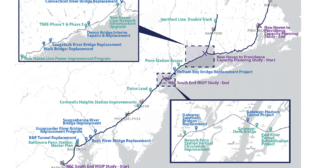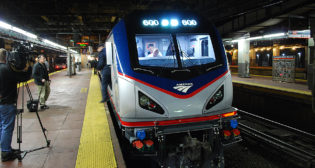
Ballast betterment
Written by Mischa Wanek-Libman, Editor, Railway Track & Structures; and Engineering Editor, Railway AgeSuppliers continue their R&D efforts to provide improved ballast maintenance solutions.
Optimizing a ballast maintenance program requires equipment with improved reliability, expanded versatility and enhanced productivity. Suppliers are ramping up their efforts to deliver equipment that ensures ballast maintenance requires less time, but delivers maximum benefit.
Brandt: Brandt Road Rail Corp. developed the RTB-130 hi-railed backhoe to meet the needs of small maintenance projects with “a stable, versatile, reliable and productive platform.” The RTB-130 is mounted on a John Deere 710 base chassis and powered by a 130-hp engine and high-capacity hydraulics to ensure maximum power is delivered to its varied attachments.
The company says reliability has also been improved on the Brandt Rail Tool with a newly engineered wheel axle, in addition to other upgrades to ensure a longer working life.
Brandt says it is aiming to help railroads accomplish more tasks with less equipment, less labor, and less track time.
BTE: No matter the situation or type of ballast, Ballast Tools Equipment (BTE) says it “has a machine and attachments to handle any situation,” but points to its BTE-312 Hi-Rail Excavator as being one of the most versatile products on the market. Matt Weyand, BTE engineer, explains the BTE-312 series’ ability to travel while undercutting helps improve productivity and safety:
“A spot problem can be cleaned up and rebuilt by a single machine, including undercutting, refilling, grading and tamping, all while working on or off rail. The 312 has ample power to effectively undercut a spot problem in the ballast, and rebuild the site, fast, allowing more repairs and resulting in better overall track condition and safer conditions for both a crew and the railroad. And we didn’t stop there; BTE built a whole system of machines, designed around our attachments, including undercutters, tampers, cribbing buckets, tie heads and tie handlers, all designed to be the best in quality, versatility and value.”
GREX: Georgetown Rail Equipment Company (GREX) says dealing with projects where traditional ballast delivery methods are insufficient requires improved maintenance solutions, such as its DumpTrain® and DumpTrain for Curves™.
“Whether the project calls for stockpiling ballast, repairing a washout or laying base material for adjacent track construction, the DumpTrain is the best tool for the job,” explained Greg Grissom, vice president engineering.
The first-generation DumpTrain utilizes a single belt that runs the length of the train, carrying material from each car as it is unloaded to the main stacker for delivery. According to GREX, the original DumpTrain’s only limiting factor is the inability to unload in significant curvature, which is where the second-generation DumpTrain comes into play. Not only can the second-generation DumpTrain unload in curves, but delivers material car to car allowing the user flexibility in the creation of custom sized trains.
GREX also reports developments in ballast inspection with its BallastSaver®, which can be integrated with the Aurora® tie inspection technology allowing for simultaneous tie and ballast assessment at speeds greater than 25 mph.
Harsco: Rail Steve Bolte, director of North American sales for Harsco Rail, says railroads turn to the company’s Spreader Ditcher to reduce the time it takes to clear and re-profile ballasted tracks. He notes that the machine produces a correct track roadbed section by cutting fouled ballast from the ends of ties and carrying, distributing and plowing clean ballast on the track.
The Spreader Ditcher was first introduced in the 1960s and underwent a redesign two years ago. Recently, the Spreader Ditcher “has been instrumental in digging out from the major winter storms across the northern states,” notes Bolte. “The Spreader Ditcher will be sure to catch your attention if you see it on the track. It’s a sizably distinct machine that assists railroads with their ditching, draining and plowing maintenance requirements.”
HRSI: The G.P.S. Ballast Train Fleet offered by Herzog Railroad Services, Inc. (HRSI) is under constant development because the company says it “is not satisfied with the status quo.”
Circuit board and unloading software is developed using the company’s GPS train simulator. HRSI notes that every board and wire is tested and retested in its Ballast Train Simulator before it is installed into its train fleet.
At the end of 2014, HRSI finished replacing its ballast fleet’s GPS antennas with its SMART/P.L.U.S. Inertial System and completed tunnel dump testing.
HRSI says utilizing the SMART/P.L.U.S. Inertial System “virtually eliminated skips during dumps, has cut down instances of GPS loss to almost nothing and allows the ballast fleet to dump in tunnels.”
Progress Rail: The Kershaw Division of Progress Rail Services Corp. recently introduced the Kershaw Model 4600 Ballast Regulator, “which utilizes strategic component location and a cab-forward design offering enhanced visibility and improved operator ergonomics,” the company says.
Kershaw’s newest entrant is the Model 66 One Pass Ballast Regulator. The machine was designed to provide full one pass ballast regulating behind high-speed production tampers. While the Model 66 One Pass Regulator was designed for high speed, it can operate as a conventional ballast regulator when required. The machine can also be equipped with a ballast hopper feature that allows the operator to transfer ballast to areas that require additional ballast.
Ballast cleaning and ballast reclamation is another area where Kershaw has been actively working with customers. Kershaw recently delivered a new KSC2000 High Speed Shoulder Cleaner that is capable of cleaning the shoulder ballast, screening and spoiling the waste and returning the cleaned ballast back onto the shoulder.
The company’s equipment leasing subsidiary, Progress Rail Equipment Leasing, has a full fleet of ballast maintenance equipment that is available for customized short-term rental or long-term leases.
Knox Kershaw: Knox Kershaw Inc. (KKI) released the KBR 860 ballast regulator last summer to replace the older KBR 850 and KBR 875 models. KKI notes the 860 “features better visibility, a new wing structure with thicker grader blades to provide extended wear and a clean roof design, which is not only safer from a maintenance standpoint, but also lowers the machine height to facilitate shipping.” The company also upgraded the engines of the KBR 860 and KBR 925 to a 260 hp engine and offers LED lights standard, as well as providing side-mounted A/C for safe and easy access.
Loram: Loram Maintenance of Way, Inc., is investing in research and development to enhance the productivity of its High Performance Shoulder Ballast Cleaners, Railvacs, Track Lifters, Track Undercutters and Badger Ditchers.
Loram says it sees an increase in utilizing ballast equipment as a part of system work gangs in major maintenance and rehab projects. The company notes that coordinating this equipment with work gangs and other track rehabilitation equipment is optimizing productivity of the equipment, work gangs and outcome of rehabilitation projects.
“Loram is investing in technology, equipment and services to get more work completed in less time. Addressing ballast maintenance on a more frequent, preventive cycle allows our customers to keep more of their system maintained and less time spent on trouble spots,” says John Simmons, marketing specialist.
Miner: Miner Enterprises, Inc., says it recently improved the performance/life cycle, of the linear actuators and electrical systems used in its Miner Electric AggreGate®, which allows independent operation of the car from anywhere within a ballast train.
Miner AggreGate is available in pry bar manual, push button or remote control operations using pneumatic or electric power to operate the gates.
“Miner has been working on ways to simplify the application of the Aggregate Systems,” says Chris Gaydos, manager mechanical engineering. “We are making these changes to help carbuilders and car shops streamline the applications and reduce labor costs.”
NMC Railway Systems: NMC Railway Systems will introduce the Cat® Hi-Rail 420 and 430 Backhoes to meet the need for an all-in-one ballast maintenance machine. NMC says the machines “are equipped to handle the demands of spot work and offer flexibility with a variety of attachments that include a six-foot undercutter bar with bi-directional chain, two-motor ballast tamper and a tie inserter with dual wood/concrete pads.”
NMC continues to expand its in-field support for all Cat m/w machinery repair, citing the increased demand for on-site repair, and notes the high demand for hi-rail machines that can access remote track, but can also work off-track due to shorter track windows.
Nordco: Nordco Inc.’s recently redesigned HST Tamper, is now within the legal width for non-permit trailering on most highways. Nordco also continues to grow its ballast fleet with the development of the XL5-T and XL5-R, a road-ready tamper and regulator that can be hauled instead of trailered.
Both the XL5-T and XL5-R can be hooked to any standard tractor for hauling between sites, and the machines load directly from road to rail at any crossing. The company also notes that the XL5-T also features Nordco’s new Absolute Displacement Vibrator that has been developed and tested for increased reliability.
Plasser American: Plasser American says its machines “are designed to work and travel at higher speeds while combining multiple work processes to help railroads reconcile tight work windows and greater maintenance requirements due to increased traffic.” Plasser’s 09-3X CW Dynamic Tamping Express has a new tamping unit design that allows for seamless changeover between concrete and wood ties. The machine also offers continuous action leveling, lifting, lining and tamping with an integrated dynamic track stabilizer.
Integrating Plasser’s new tamping unit with its Automated Tie Locating Analyzing System and Automated Tamping Tool Adjustment allows the 09-3X CW Dynamic to detect tie spacing and adjust the tamping units and tools to tamp three ties or one tie automatically.
Plasser first introduced the RM-802 high-speed ballast undercutter-cleaner in 1995 utilizing the pre-dumped ballast concept “resulting in much higher production rates.” The company says the next generation of this machine includes an FRM-802 shoulder cleaner to pick up and clean the shoulder ballast, which is then mixed with the new pre-dumped ballast that has been picked up by the Ballast Pick-Up Unit and returned to the RM-802 Undercutter, where it is deposited back into the track behind the cutter bar while the track is still suspended in the air.
RCE: Rail Construction Equipment Company (RCE) says it can now supply the 135G, 245G, 250G and 350G excavators with undercutter bars.“By increasing these options, our customer base can perform undercutting with all our models of hi-rail or standard excavators,” explains Dennis Hanke, sales manager.
RCE, which is continuing to offer all of its track maintenance equipment either for sale, lease or rental, says that its Railavator is “a highly versatile option that can be used in many maintenance applications including undercutting, pulling rail, cutting brush, craning, tamping ties, or just digging and trenching.



